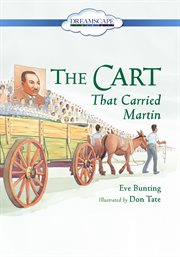Review by Booklist Review
*Starred Review* Short on text but long on symbolic meaning and emotional impact, this offers up something far different than a typical biography, with its stunning recollection of Martin Luther King Jr.'s funeral procession through Atlanta. The caisson that carried King's body was a simple wooden cart borrowed from a closed antique store, hastily painted, and attached to two young mules. Disarming in its ordinariness, this cart carried King for three miles, winding its way through the streets of Atlanta to Ebenezer Baptist Church, past the Georgia State Capitol building, where onlookers sang We Shall Overcome, and on to the quad at Morehouse College. Tate's watercolors take on an ever-wider scope as the crowd of mourners swells, but they're worthy of careful attention, too, as details of King's life and work are alluded to throughout. They perfectly complement Bunting's straightforward but elegant narrative; together, they support quite a bit of symbolism while maintaining a strong sense of realism. This inspired title could be the impetus for countless important discussions about Martin Luther King Jr. and the civil rights movement, both of which began small but grew into remarkable historical forces.--Anderson, Erin Copyright 2010 Booklist
From Booklist, Copyright (c) American Library Association. Used with permission.
Review by Publisher's Weekly Review
Bunting's (Have You Seen My New Blue Socks?) impressionistic, dramatic recreation of Martin Luther King, Jr.'s funeral procession covers much of the same ground as Belle, The Last Mule at Gee's Bend by Calvin Alexander Ramsey and Bettye Stroud (2011). In clipped prose, Bunting writes of the weather-beaten farm cart borrowed for the job ("Its paint had faded.... Nobody wanted it") and of the thousands who came out to pay final respects: "The church throbbed with the sounds of singing. The songs were not sad, but there was a terrible sadness in them anyway." Tate's (Hope's Gift) loose pencil and gouache art balances emotionally charged close-up images of mourners with broader scenes in which crowds flank the mule-drawn cart on its journey through Atlanta. In a birds-eye view of the scene at King's alma mater, Morehouse College, a vast, gray sea of people fills the school's quadrangle for a second memorial service. The final pages reveal the cart's current home and further emphasize the humility of a vehicle "that, not so long ago, carried greatness." Ages 6-9. Illustrator's agent: Caryn Wiseman, Andrea Brown Literary Agency. (Nov.) (c) Copyright PWxyz, LLC. All rights reserved.
(c) Copyright PWxyz, LLC. All rights reserved
Review by School Library Journal Review
Gr 1-5-Eve Bunting's account (Charlesbridge, 2013) of the humble cart that carried Martin Luther King, Jr.'s casket, here becomes a read-along DVD. The treatment of Don Tate's artwork is the best thing about this presentation. Moving shots of the illustrations, rather than static ones, reflect the magnitude of the day's events and the size of the crowds along the funeral procession route. Beyond that, the book is not satisfactorily represented. The read-along text contains at least four spelling errors and one punctuation mistake. Sean Crisden's narration is also problematic. At first, it has a friendly, reassuring lilt, which might make the somber content more palatable for younger listeners. But as the book progresses, Crisden's voice becomes too upbeat in jarring contrast to the solemn text, especially the passage describing King's coffin and his spirit. Crisden varies his voice to a degree as different characters speak, but it's not always fitting. On the other hand, the muted sounds of church bells, wagon wheels, the mules' hooves, the singing of hymns, and the murmur of the crowd are effective accompaniments.-Alyson Low, Fayetteville Public Library, AR (c) Copyright 2014. Library Journals LLC, a wholly owned subsidiary of Media Source, Inc. No redistribution permitted.
(c) Copyright Library Journals LLC, a wholly owned subsidiary of Media Source, Inc. No redistribution permitted.
Review by Horn Book Review
At his funeral, Martin Luther King Jr.'s casket was carried in a borrowed wooden farm cart pulled by two mules. It's a humble image, but the throngs of people lining the streets to pay their respects reflect Dr. King's great work and legacy. Bunting's simple, poetic prose follows the cart's slow, sad procession; Tate's somber, handsome gouache illustrations are a perfect accompaniment. (c) Copyright 2014. The Horn Book, Inc., a wholly owned subsidiary of Media Source, Inc. No redistribution permitted.
(c) Copyright The Horn Book, Inc., a wholly owned subsidiary of Media Source, Inc. No redistribution permitted.
Review by Kirkus Book Review
An old, unwanted cart becomes part of Dr. Martin Luther King's funeral procession. Two men borrow the cart from an antiques store and paint it green, the color of freshly watered grass. They take it to the Ebenezer Baptist Church and hitch two mules to it. Outside the church, crowds gather, while inside, the pews are filled with a weeping congregation. Slowly, the mules pull the cart carrying Dr. King's coffin through the streets of Atlanta to Morehouse College for a second service. The cart, its day's journey completed, is now part of the Martin Luther King Jr. National Historic Site. Bunting uses simple declarative sentences to capture the sorrow of the day and the message that King's followers were intent upon proclaiming--his greatness came from humble beginnings. The mules, Belle and Ada, were a reminder that upon freedom, slaves were given forty acres and a mule. Tate's pencil-and-gouache artwork plays up the details of the cart and the two mules while depicting the crowds of mourners less distinctly. Adults looking for a title to share with young readers will find this helpful in imparting the emotions raised by King's assassination. An affecting snapshot of a tragic day. (afterword) (Picture book. 4-7)]] Copyright Kirkus Reviews, used with permission.
Copyright (c) Kirkus Reviews, used with permission.


